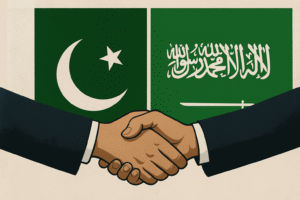Drone Swarms and the Risk of Escalation in South Asia.

Drone Swarms and the Risk of Escalation in South Asia.
In the contemporary strategic landscape of South Asia, drone swarms are adding a dangerous layer of complexity to an already volatile security situation. The recent May 2025 Indo-Pakistan crisis has shown that drone swarms can play a major escalatory role in the regional strategic dynamics. Drone Swarms are identified as multiple Unmanned platforms or/and weapons deployed to accomplish a shared objective. Even though, these systems are still semi-autonomous, these platforms may autonomously alter their behavior through communication with one another.
Although the inherent nature of drones makes them tactically appealing but their use in conventional conflicts is dangerous and in nuclear theaters, potentially catastrophic. They can be deployed to decoy an adversary’s air defence, and can therefore pave the way for a missile or large-scale attack. This tactic has been witnessed in the ongoing Russia-Ukraine conflict. In November 2024, Russia launched swarms of drones toward Ukraine. 50–60% of these were decoys like the Gerbera and Parodiya.
They were built from simple materials such as plywood and foam, with gadgets that made them appear radar-significant. These decoys tricked Ukrainian air defenses and compelled them to waste interceptors on fake targets. This strategy, known as Operation False Target, drained resources and created gaps in Ukrainian defense. Russian forces then capitalized on those openings to dispatch actual armed drones or missiles to hit real targets. The lesson here is that drone swarms do not just supplement war rather redefine it.
Similarly, drone swarms increase the precision of targeting by gathering prior intelligence, surveillance, and reconnaissance (ISR). This enables surgical strikes that may tempt nuclear-armed states to go for preemptive counter force attack. As a result, undermines deterrence stability. More critically, swarms can lead to a “fog of war” thereby confusing a minor drone incursion for a larger incoming assault. In South Asia, where India and Pakistan are nuclear powers with a delicate deterrence based on nuclear weapons, this could be a recipe for greater destruction.
Unlike conventional attacks, where states have time for deliberation, diplomacy, or international mediation, drone swarm attacks accelerate escalation. A rapid drone swarm attack could trigger retaliation exponentially. The very nature of swarms, fast, hard to track, and launched masses, means that decision-makers may have only minutes to respond, often relying on automated systems and high-alert postures that magnify the margin of error.
Moreover, drone swarms could embolden offensive measures by giving a deceptive belief to countries that they can defend themselves by deterrence through denial. Imagine hundreds of cheap, simple drones forming a dome over a high-value target and intercepting incoming missiles. The same drones can also function as airborne mines that damage aircrafts. Their low cost and easy accessibility make them an attractive tool of warfare.
The recent 4-day conflict between India and Pakistan is a case in point that turned a mere concerns into operational realities.</a> The crisis represented the first example where both Indian and Pakistan’s military used drones as kinetic platforms to target military assets. The exchange of drones started when India launched 30 Israeli-made Kamikaze drones towards Pakistan on the night of May 7-8. The drones were aimed to suppress Pakistan’s air defence mission (SEAD), assess the response of Pakistan’s air defence network, and identify the locations of camouflaged early warning radars and surface-to-air missile batteries. The first wave was followed by the second and third during the crisis. Pakistan successfully intercepted majority of Indian drones. India claimed that Pakistan launched nearly 300 drones towards India, but this claim has yet to be verified by independent sources.
This initiation of drone warfare by India has further minimized the kahns escalation ladder and complicated conventional conflict between India and Pakistan. It is particularly dangerous now, as the shorter flight times of missiles and advanced targeting systems compress the window for diplomatic intervention as was shown during the early time of the crisis. It was only Pakistan’s proportionate response that compelled India to go and the US mediation to put an end to the crisis .
To avoid any apocalyptic future, confidence-building measures (CBMs) are the first step to be taken. Both countries must strive to strengthen the existing hotline between the Director General Military Operations (DGMOs) of Pakistan and India. A bilateral framework between Islamabad and Delhi, if established, could help bring transparency in deploying drones around border sensitive areas while potentially regulating drone deployments. This measure would mitigate the chances of miscalculation in a region where mistrust and mutual suspicion are prevalent.
Moreover, Pakistan must deploy its diplomatic corps to further expose and counter India’s drone belligerency. Islamabad must raise the issue at international forums and document repeated violations of its airspace. Through this Pakistan can build global pressure on India and restrain its militarized drone ambitions. This could be one small step towards ensuring strategic stability in South Asia. However, the onus of responsibility for stable peace does not lie only with Pakistan. India too must give thought to its conscience, that its drone belligerency will bring naught but instability in the region.



